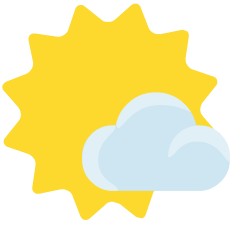🌤Meaning and Description
The emoji 🌤 is a weather symbol. It presents a sun that's mostly visible, with a small cloud in the bottom right corner, suggesting a day that's mostly sunny with a bit of cloudiness.
It's widely used to represent weather conditions - those partly sunny days where you might need sunglasses🕶️ but should keep an umbrella handy☂. In addition, you can use this emoji as a symbol of optimism and hope, often used to convey a positive outlook or a situation improving after a challenging period.
Furthermore, in a more unique and creative usage, this emoji can signify a subtle shift in mood or circumstances, like when someone is slowly overcoming a challenge or feeling slightly better after a tough time. It's like saying, "Things are looking up, but I'm not out of the woods yet."
It's also used to describe one's mood - not entirely sunny and happy, but also not completely clouded or sad. It's perfect for those days when you're feeling okay but not fantastic.
It's widely used to represent weather conditions - those partly sunny days where you might need sunglasses🕶️ but should keep an umbrella handy☂. In addition, you can use this emoji as a symbol of optimism and hope, often used to convey a positive outlook or a situation improving after a challenging period.
Furthermore, in a more unique and creative usage, this emoji can signify a subtle shift in mood or circumstances, like when someone is slowly overcoming a challenge or feeling slightly better after a tough time. It's like saying, "Things are looking up, but I'm not out of the woods yet."
It's also used to describe one's mood - not entirely sunny and happy, but also not completely clouded or sad. It's perfect for those days when you're feeling okay but not fantastic.
💡Extended reading and popular science
The meaning of emoji symbol 🌤 is sun behind small cloud, it is related to cloud, sun, it can be found in emoji category: "🚌 Travel & Places" - "☂️ Sky & Weather".
🔸 🌤 (1F324) There is no Emoji version of this Unicode character, which means that on most mobile phones or computer systems, the character can only be displayed in black and white character style, but in a few good compatibility platforms, it can still display color picture style. The Unicode organization does not yet recommend its use as a universal emoji symbol.
🌤 (1F324) - unqualified Emoji, See also: 🌤️ (1F324 FE0F) - fully-qualified Emoji.
The current 🌤 is a basic Emoji without variant symbols, and there are two Emoji variation sequences corresponding to it: 🌤️ (emoji style, displaying colorful symbols on most new platforms) and 🌤︎ (text style, displaying black and white symbols on some old platforms).🌤Examples and Usage
🌤Images from Various Manufacturers
🌤Basic Information
| Emoji: | 🌤 |
| Shortname: | sun behind small cloud |
| Codepoint: | U+1F324 Copy |
| Decimal: | ALT+127780 |
| Unicode Version: | 7.0 (2014-06-16) |
| Emoji Version: | None |
| Categories: | 🚌 Travel & Places |
| Sub Categories: | ☂️ Sky & Weather |
| Keywords: | cloud | sun | sun behind small cloud |
| Proposal: | L2/11‑052 |
👨💻Unicode Information (Advanced Usage)
🌤Trend Chart
🌤Popularity rating over time
Date Range: 2019-04-14 - 2024-04-14
Update Time: 2024-04-17 18:04:57 UTC Emoji 🌤 was released in 2019-07.
Update Time: 2024-04-17 18:04:57 UTC Emoji 🌤 was released in 2019-07.
🌤See also
🌤Relative Topic
🌤Extended Content
🌤More Languages
| Language | Short Name & Link |
|---|---|
| Arabic | 🌤 شمس خلف سحابة صغيرة |
| Bulgarian | 🌤 Слънце зад малък облак |
| Chinese, Simplified | 🌤 晴偶有云 |
| Chinese, Traditional | 🌤 晴偶有雲 |
| Croatian | 🌤 sunce iza malog oblaka |
| Czech | 🌤 slunce za malým mrakem |
| Danish | 🌤 sol bag lille sky |
| Dutch | 🌤 zon achter kleine wolk |
| Filipino | 🌤 araw sa likod ng maliit na ulap |
| Finnish | 🌤 aurinko ja pieni pilvi |
Search
Recents
No recent use emoji
Emojify...
Emojify Success




















